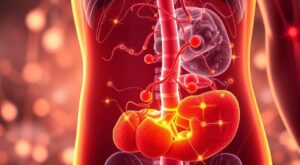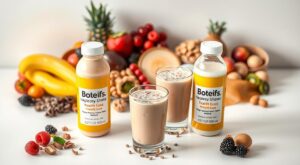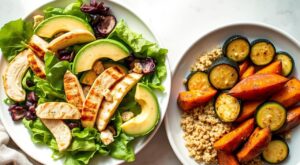Did you know adding whole grains to your diet can boost your metabolism by up to 10%? This is a key reason why foods like oats and quinoa are vital. They help increase your metabolic rate and support weight management.
These grains are full of nutrients that keep you full and balance your blood sugar. They’re perfect for breakfast or as a side dish. Knowing how oats and quinoa boost your metabolism can help you lose weight.
What Are Whole Grains and Why They Matter
Whole grains are key to a healthy diet, full of nutrients that boost wellness. Knowing what whole grains are and their benefits helps you choose better meals.
Definition of Whole Grains
Whole grains have the bran, germ, and endosperm parts of the grain kernel. This mix gives you lots of nutrients that refined grains don’t have. Eating whole grains can improve digestion and health.
Nutritional Benefits of Whole Grains
The whole grains nutrition facts show many benefits. They are rich in dietary fiber, vitamins, and minerals. These nutrients are important for:
- Enhancing digestion
- Promoting heart health
- Assisting in weight management
Studies show that eating whole grains can lower the risk of chronic diseases. Adding different whole grains to your meals can greatly improve your health. For creative ways to use whole grains, check out some healthy food ideas that include them.
The Science of Metabolism
Understanding metabolism is key for better health and weight loss. It’s how your body turns food into energy. This energy powers important functions like breathing and digestion. The speed at which your body uses this energy depends on several factors.
What Is Metabolism?
Metabolism is always working, even when you’re not moving. It has two parts: breaking down molecules for energy and building new compounds for growth. A faster metabolism means you burn more calories, helping with weight management. Eating foods that boost metabolism can help you lose weight.
Factors Affecting Metabolism
Many things can change how fast your metabolism is. These include:
- Age: Metabolism slows down as you get older.
- Body Composition: More muscle means a faster metabolism.
- Physical Activity: Exercise boosts your metabolism.
- Diet: Eating whole grains can help your metabolism, as they build lean body mass.
Eating foods that boost metabolism, like whole grains, can help your body burn calories better.

Oats: The Metabolism Marvel
Oats are known as a superfood, great for boosting your metabolism. They are full of nutrients that help your body and mind. Their special mix of amino acids and fibers makes them stand out among whole grains.
Health Benefits of Oats
Oats have many health perks. They are rich in soluble fiber, like beta-glucan. This fiber is good for your heart and can lower cholesterol.
Oats also help with digestion and keep blood sugar levels steady. They are perfect for those trying to manage their weight.
How Oats Boost Metabolism
Oats have a unique thermic effect that requires more energy to digest. This can help increase your metabolism and burn fat. They are not just tasty but also give you lasting energy, keeping you full longer.
Adding oats to your diet can improve your metabolic rate. They are a great choice for anyone serious about fitness and health.

| Nutrient | Amount per 100g |
|---|---|
| Calories | 389 |
| Protein | 16.9g |
| Total Fat | 6.9g |
| Carbohydrates | 66.3g |
| Dietary Fiber | 10.6g |
| Sugars | 0.9g |
Quinoa: A Complete Protein
Quinoa is special among whole grains because it’s a complete protein. It has all nine essential amino acids your body needs. Eating quinoa helps repair muscles and boosts your metabolism.
Nutritional Profile of Quinoa
Quinoa is packed with nutrients. A serving of cooked quinoa gives you:
| Nutrient | Amount per 1 cup (185g) |
|---|---|
| Calories | 222 |
| Protein | 8g |
| Dietary Fiber | 5g |
| Carbohydrates | 39g |
| Fat | 4g |
| Iron | 2.8mg (15% DV) |
This makes you feel full longer, which helps with weight control. Health experts often recommend whole grains for weight loss. Quinoa is a great choice.
Quinoa’s Impact on Metabolic Rate
Quinoa’s protein and fiber boost your metabolism. Eating whole grains like quinoa can help you lose weight. It’s a great addition to your diet for protein and metabolic health.

Other Whole Grains to Consider
When looking for whole grains to boost your metabolism, don’t miss out on brown rice, barley, and farro. Each grain has its own nutritional benefits and helps your overall health. Adding different grains to your diet brings more health benefits and essential nutrients for a healthy metabolism.
Brown Rice
Brown rice is a great source of dietary fiber, which aids digestion and keeps your gut healthy. It also provides sustained energy, helping you stay energized all day. Eating brown rice regularly can boost your metabolism and support a balanced diet.
Barley
Barley is high in soluble fiber, which helps control hunger and blood sugar. It’s known for making you feel full and can help with weight management. Adding barley to your meals can help boost your metabolism.
Farro
Farro is a nutrient-rich grain with protein, fiber, and vitamins and minerals. It’s tasty and keeps your energy up, making it great for metabolism. Farro is easy to add to many dishes, bringing more health benefits.

How to Incorporate Whole Grains into Your Diet
Adding whole grains to your meals can boost your nutrition and give you energy all day. These grains are great for any diet, fitting well in breakfast, lunch, and dinner.
Breakfast Ideas
Starting your day with a healthy breakfast is key. Here are some ideas:
- Oatmeal with fresh fruits and nuts adds flavor and crunch.
- Whole grain toast with avocado and a poached egg offers healthy fats and protein.
- Quinoa porridge with almond milk and bananas gives a twist to traditional grains.
Lunch and Dinner Suggestions
Whole grains are also important for lunch and dinner. Here are some ideas:
- A quinoa salad with colorful veggies and protein is refreshing and nutritious.
- Stir-fries with brown rice or barley make for a hearty meal.
- Chili or stews with farro or whole grain pasta add texture and nutrition.

The Role of Fiber in Metabolism
Fiber is key to a healthy diet and plays a big role in metabolic health. Your body needs two main types of fiber: soluble and insoluble. Knowing the difference helps you choose more fiber-rich whole grains for your meals.
Soluble vs. Insoluble Fiber
Soluble fiber turns into a gel in your stomach. It helps lower cholesterol and keep blood sugar stable. You can find it in oats, barley, and legumes.
Insoluble fiber doesn’t dissolve in water. It makes your stool bulkier, helping you go to the bathroom regularly. Whole grains like wheat and quinoa are full of insoluble fiber.
Fiber-Rich Whole Grains
Fiber-rich whole grains are vital for a good metabolism. Grains like brown rice, oats, and quinoa are full of fiber. They help with digestion and make you feel full, preventing overeating.
Knowing the nutrition facts of whole grains shows their importance. They help control blood sugar, which is good for your metabolism.
Portion Control and Whole Grains
Adding whole grains to your diet for weight loss? Remember to control your portions. This way, you get the most out of whole grains without overeating.
Recommended Serving Sizes
For whole grains, aim for 1/2 cup to 1 cup when cooked. Here’s a quick guide to serving sizes for some common whole grains:
| Whole Grain | Serving Size (Cooked) |
|---|---|
| Brown Rice | 1 cup |
| Quinoa | 1 cup |
| Barley | 1/2 cup |
| Oats | 1 cup |
Balancing Grains with Other Foods
To make a balanced meal, pair whole grains with veggies, lean proteins, and healthy fats. This mix not only tastes great but also keeps you full. It helps you enjoy the health perks of whole grains while keeping your meals tasty and filling.
Conclusion: Fueling Your Body with Whole Grains
Adding whole grains to your daily meals is more than a trend. It’s a choice that boosts your health in the long run. These foods improve digestion and energy, helping you stay healthy.
Whole grains are full of fiber. This fiber helps your body burn energy better. It supports your weight loss goals and keeps you full of life.
The Long-Term Benefits
Eating whole grains regularly can change your life. They lower the risk of serious diseases and improve heart health. They also help control blood sugar and keep your gut healthy.
Choosing whole grains is not just about getting nutrients. It’s about building a healthy eating habit that lasts. It keeps you feeling good and satisfied.
Building a Sustainable Diet
To eat well for life, focus on whole grains. They fuel your body and help you develop lasting healthy habits. Try different whole grains like oats, quinoa, and brown rice to make your meals better.
Make smart choices about what you eat. See how these choices improve your health and well-being.














